Developing Managerial Skills: Analyzing Learning Logs on Key Aspects
VerifiedAdded on 2023/06/15
|6
|1457
|230
Report
AI Summary
This report comprises four learning logs focusing on various aspects of management and leadership. The first log emphasizes self-awareness and effective communication, highlighting their importance in building cohesion and improving organizational performance. The second log discusses mentoring, developing others, managing, and leading groups, stressing the need for skills development and effective team dynamics. The third log addresses managing conflicts and establishing internal process controls, differentiating between task and relationship conflicts and outlining competencies for constructive conflict management. The fourth log focuses on managing work across functions, emphasizing the role of functional management, project management methodologies, and key guidelines for cross-functional coordination. Together, these logs provide insights into essential management competencies and their application in enhancing organizational effectiveness. Desklib offers a range of similar solved assignments and resources for students.
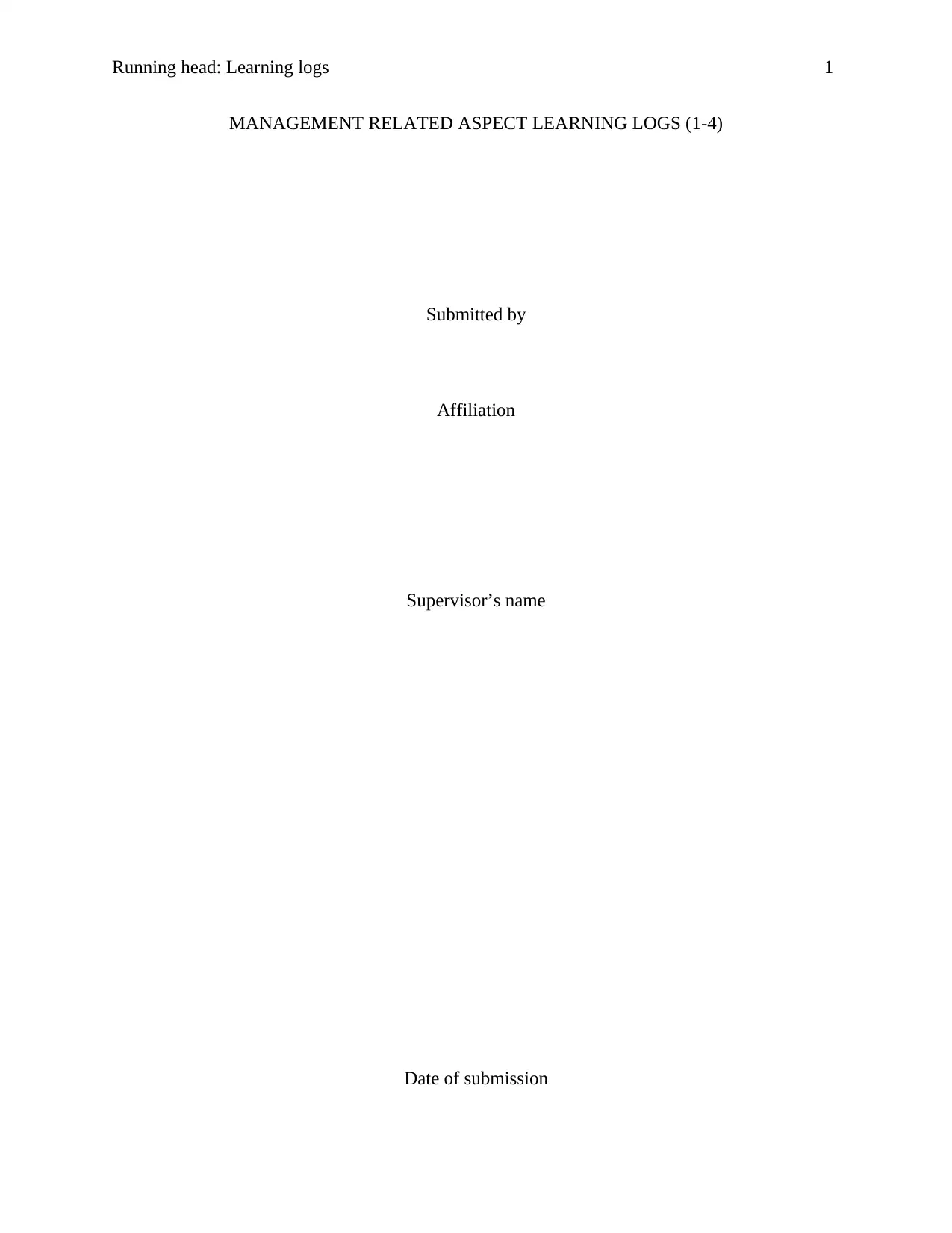
Running head: Learning logs 1
MANAGEMENT RELATED ASPECT LEARNING LOGS (1-4)
Submitted by
Affiliation
Supervisor’s name
Date of submission
MANAGEMENT RELATED ASPECT LEARNING LOGS (1-4)
Submitted by
Affiliation
Supervisor’s name
Date of submission
Paraphrase This Document
Need a fresh take? Get an instant paraphrase of this document with our AI Paraphraser
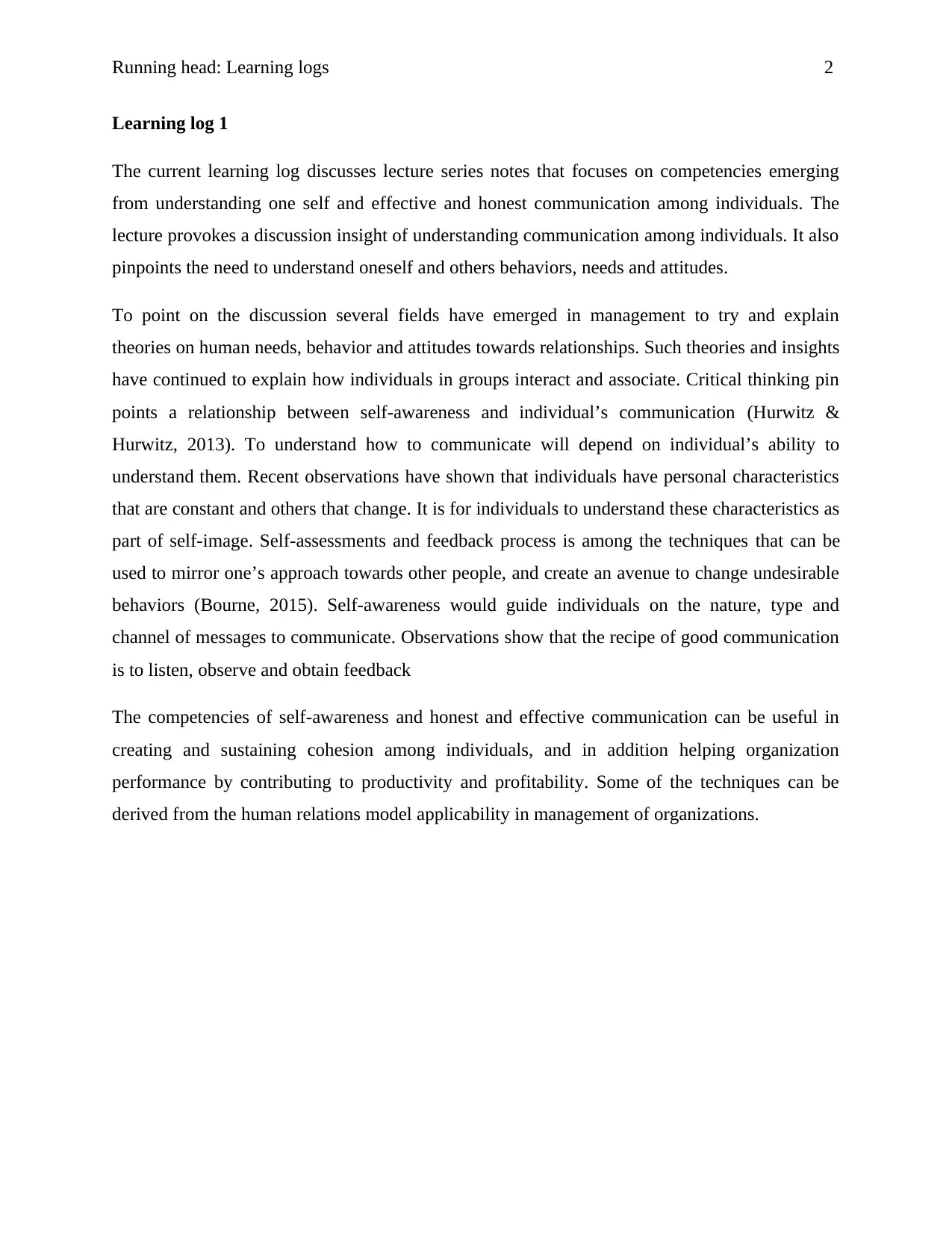
Running head: Learning logs 2
Learning log 1
The current learning log discusses lecture series notes that focuses on competencies emerging
from understanding one self and effective and honest communication among individuals. The
lecture provokes a discussion insight of understanding communication among individuals. It also
pinpoints the need to understand oneself and others behaviors, needs and attitudes.
To point on the discussion several fields have emerged in management to try and explain
theories on human needs, behavior and attitudes towards relationships. Such theories and insights
have continued to explain how individuals in groups interact and associate. Critical thinking pin
points a relationship between self-awareness and individual’s communication (Hurwitz &
Hurwitz, 2013). To understand how to communicate will depend on individual’s ability to
understand them. Recent observations have shown that individuals have personal characteristics
that are constant and others that change. It is for individuals to understand these characteristics as
part of self-image. Self-assessments and feedback process is among the techniques that can be
used to mirror one’s approach towards other people, and create an avenue to change undesirable
behaviors (Bourne, 2015). Self-awareness would guide individuals on the nature, type and
channel of messages to communicate. Observations show that the recipe of good communication
is to listen, observe and obtain feedback
The competencies of self-awareness and honest and effective communication can be useful in
creating and sustaining cohesion among individuals, and in addition helping organization
performance by contributing to productivity and profitability. Some of the techniques can be
derived from the human relations model applicability in management of organizations.
Learning log 1
The current learning log discusses lecture series notes that focuses on competencies emerging
from understanding one self and effective and honest communication among individuals. The
lecture provokes a discussion insight of understanding communication among individuals. It also
pinpoints the need to understand oneself and others behaviors, needs and attitudes.
To point on the discussion several fields have emerged in management to try and explain
theories on human needs, behavior and attitudes towards relationships. Such theories and insights
have continued to explain how individuals in groups interact and associate. Critical thinking pin
points a relationship between self-awareness and individual’s communication (Hurwitz &
Hurwitz, 2013). To understand how to communicate will depend on individual’s ability to
understand them. Recent observations have shown that individuals have personal characteristics
that are constant and others that change. It is for individuals to understand these characteristics as
part of self-image. Self-assessments and feedback process is among the techniques that can be
used to mirror one’s approach towards other people, and create an avenue to change undesirable
behaviors (Bourne, 2015). Self-awareness would guide individuals on the nature, type and
channel of messages to communicate. Observations show that the recipe of good communication
is to listen, observe and obtain feedback
The competencies of self-awareness and honest and effective communication can be useful in
creating and sustaining cohesion among individuals, and in addition helping organization
performance by contributing to productivity and profitability. Some of the techniques can be
derived from the human relations model applicability in management of organizations.
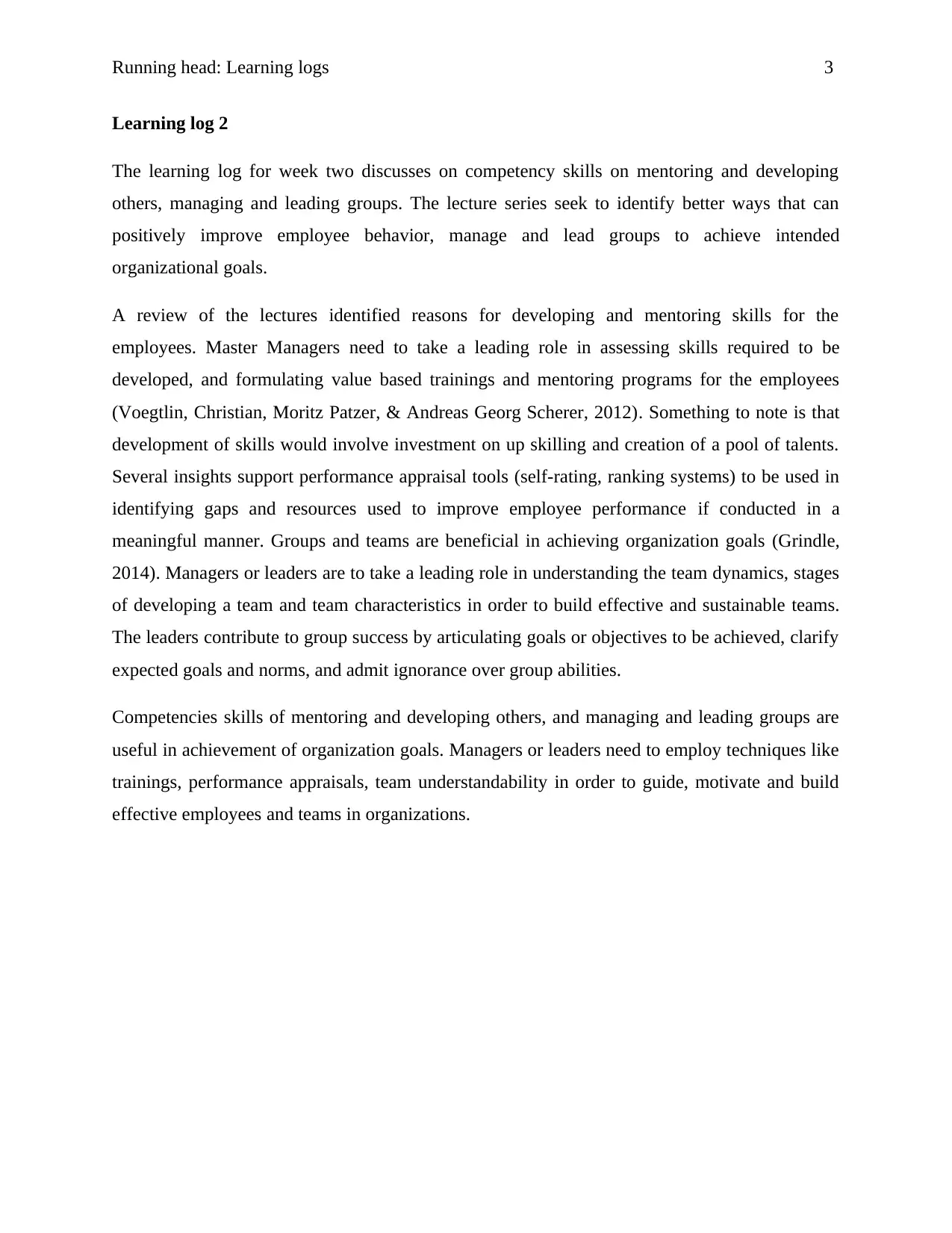
Running head: Learning logs 3
Learning log 2
The learning log for week two discusses on competency skills on mentoring and developing
others, managing and leading groups. The lecture series seek to identify better ways that can
positively improve employee behavior, manage and lead groups to achieve intended
organizational goals.
A review of the lectures identified reasons for developing and mentoring skills for the
employees. Master Managers need to take a leading role in assessing skills required to be
developed, and formulating value based trainings and mentoring programs for the employees
(Voegtlin, Christian, Moritz Patzer, & Andreas Georg Scherer, 2012). Something to note is that
development of skills would involve investment on up skilling and creation of a pool of talents.
Several insights support performance appraisal tools (self-rating, ranking systems) to be used in
identifying gaps and resources used to improve employee performance if conducted in a
meaningful manner. Groups and teams are beneficial in achieving organization goals (Grindle,
2014). Managers or leaders are to take a leading role in understanding the team dynamics, stages
of developing a team and team characteristics in order to build effective and sustainable teams.
The leaders contribute to group success by articulating goals or objectives to be achieved, clarify
expected goals and norms, and admit ignorance over group abilities.
Competencies skills of mentoring and developing others, and managing and leading groups are
useful in achievement of organization goals. Managers or leaders need to employ techniques like
trainings, performance appraisals, team understandability in order to guide, motivate and build
effective employees and teams in organizations.
Learning log 2
The learning log for week two discusses on competency skills on mentoring and developing
others, managing and leading groups. The lecture series seek to identify better ways that can
positively improve employee behavior, manage and lead groups to achieve intended
organizational goals.
A review of the lectures identified reasons for developing and mentoring skills for the
employees. Master Managers need to take a leading role in assessing skills required to be
developed, and formulating value based trainings and mentoring programs for the employees
(Voegtlin, Christian, Moritz Patzer, & Andreas Georg Scherer, 2012). Something to note is that
development of skills would involve investment on up skilling and creation of a pool of talents.
Several insights support performance appraisal tools (self-rating, ranking systems) to be used in
identifying gaps and resources used to improve employee performance if conducted in a
meaningful manner. Groups and teams are beneficial in achieving organization goals (Grindle,
2014). Managers or leaders are to take a leading role in understanding the team dynamics, stages
of developing a team and team characteristics in order to build effective and sustainable teams.
The leaders contribute to group success by articulating goals or objectives to be achieved, clarify
expected goals and norms, and admit ignorance over group abilities.
Competencies skills of mentoring and developing others, and managing and leading groups are
useful in achievement of organization goals. Managers or leaders need to employ techniques like
trainings, performance appraisals, team understandability in order to guide, motivate and build
effective employees and teams in organizations.
⊘ This is a preview!⊘
Do you want full access?
Subscribe today to unlock all pages.

Trusted by 1+ million students worldwide
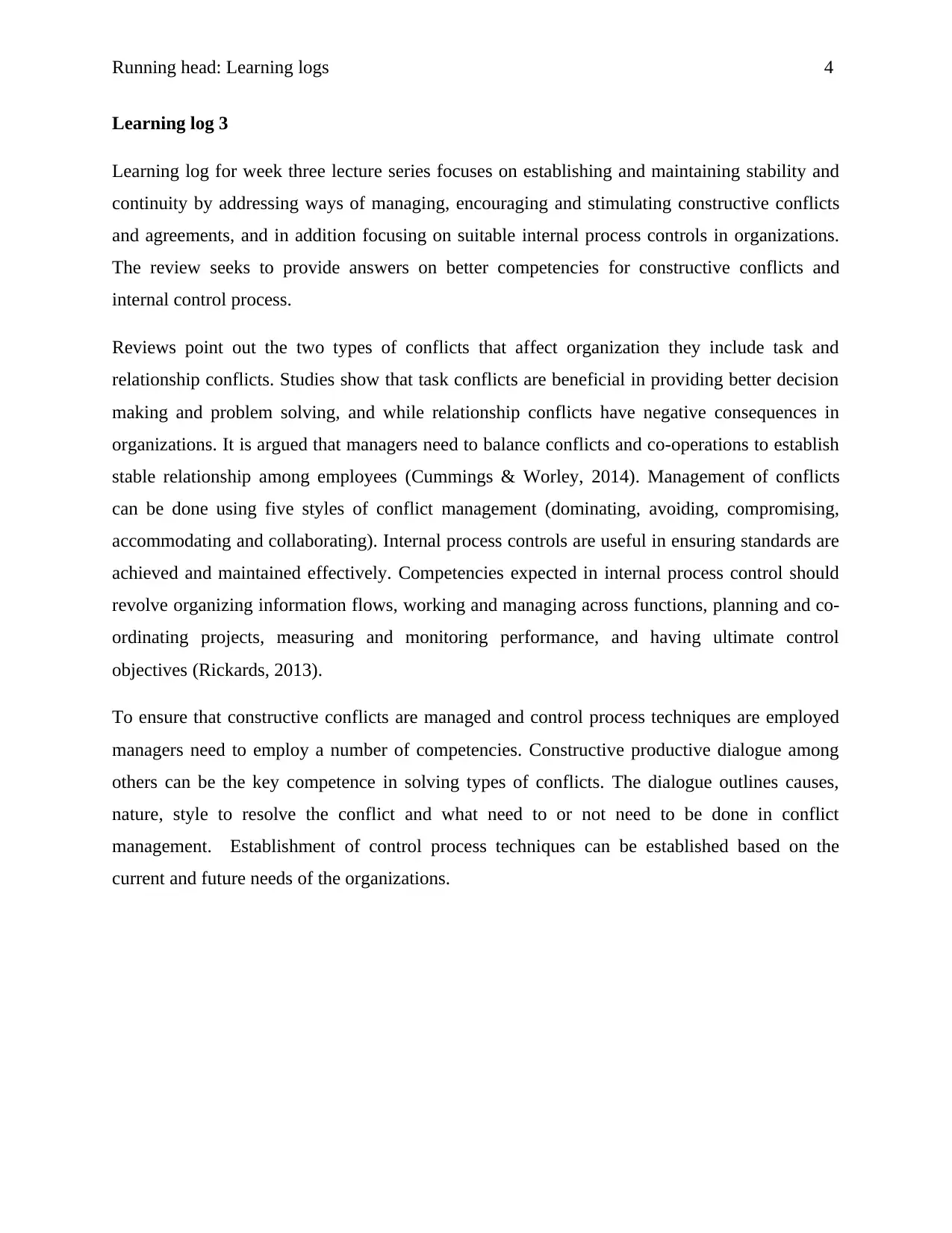
Running head: Learning logs 4
Learning log 3
Learning log for week three lecture series focuses on establishing and maintaining stability and
continuity by addressing ways of managing, encouraging and stimulating constructive conflicts
and agreements, and in addition focusing on suitable internal process controls in organizations.
The review seeks to provide answers on better competencies for constructive conflicts and
internal control process.
Reviews point out the two types of conflicts that affect organization they include task and
relationship conflicts. Studies show that task conflicts are beneficial in providing better decision
making and problem solving, and while relationship conflicts have negative consequences in
organizations. It is argued that managers need to balance conflicts and co-operations to establish
stable relationship among employees (Cummings & Worley, 2014). Management of conflicts
can be done using five styles of conflict management (dominating, avoiding, compromising,
accommodating and collaborating). Internal process controls are useful in ensuring standards are
achieved and maintained effectively. Competencies expected in internal process control should
revolve organizing information flows, working and managing across functions, planning and co-
ordinating projects, measuring and monitoring performance, and having ultimate control
objectives (Rickards, 2013).
To ensure that constructive conflicts are managed and control process techniques are employed
managers need to employ a number of competencies. Constructive productive dialogue among
others can be the key competence in solving types of conflicts. The dialogue outlines causes,
nature, style to resolve the conflict and what need to or not need to be done in conflict
management. Establishment of control process techniques can be established based on the
current and future needs of the organizations.
Learning log 3
Learning log for week three lecture series focuses on establishing and maintaining stability and
continuity by addressing ways of managing, encouraging and stimulating constructive conflicts
and agreements, and in addition focusing on suitable internal process controls in organizations.
The review seeks to provide answers on better competencies for constructive conflicts and
internal control process.
Reviews point out the two types of conflicts that affect organization they include task and
relationship conflicts. Studies show that task conflicts are beneficial in providing better decision
making and problem solving, and while relationship conflicts have negative consequences in
organizations. It is argued that managers need to balance conflicts and co-operations to establish
stable relationship among employees (Cummings & Worley, 2014). Management of conflicts
can be done using five styles of conflict management (dominating, avoiding, compromising,
accommodating and collaborating). Internal process controls are useful in ensuring standards are
achieved and maintained effectively. Competencies expected in internal process control should
revolve organizing information flows, working and managing across functions, planning and co-
ordinating projects, measuring and monitoring performance, and having ultimate control
objectives (Rickards, 2013).
To ensure that constructive conflicts are managed and control process techniques are employed
managers need to employ a number of competencies. Constructive productive dialogue among
others can be the key competence in solving types of conflicts. The dialogue outlines causes,
nature, style to resolve the conflict and what need to or not need to be done in conflict
management. Establishment of control process techniques can be established based on the
current and future needs of the organizations.
Paraphrase This Document
Need a fresh take? Get an instant paraphrase of this document with our AI Paraphraser
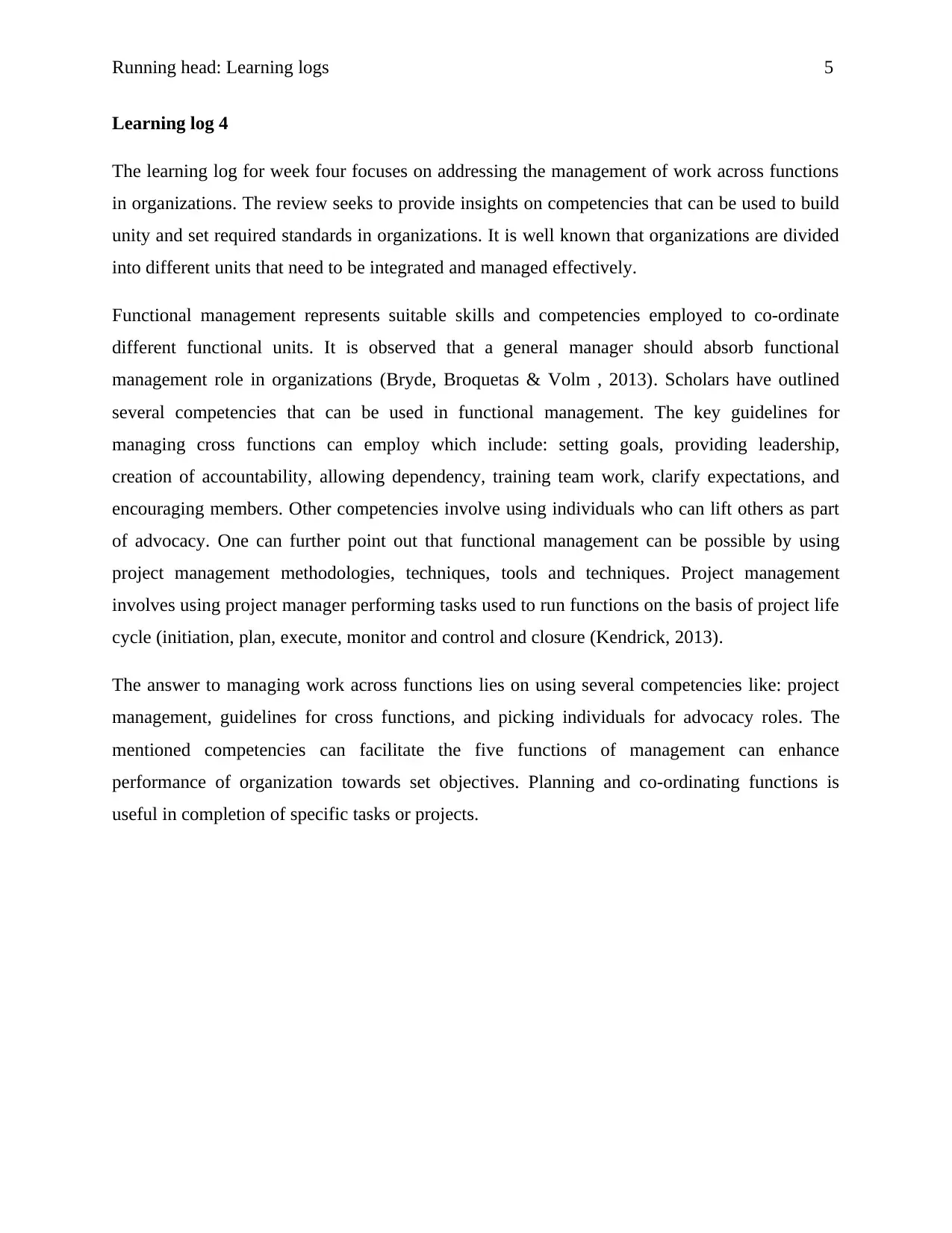
Running head: Learning logs 5
Learning log 4
The learning log for week four focuses on addressing the management of work across functions
in organizations. The review seeks to provide insights on competencies that can be used to build
unity and set required standards in organizations. It is well known that organizations are divided
into different units that need to be integrated and managed effectively.
Functional management represents suitable skills and competencies employed to co-ordinate
different functional units. It is observed that a general manager should absorb functional
management role in organizations (Bryde, Broquetas & Volm , 2013). Scholars have outlined
several competencies that can be used in functional management. The key guidelines for
managing cross functions can employ which include: setting goals, providing leadership,
creation of accountability, allowing dependency, training team work, clarify expectations, and
encouraging members. Other competencies involve using individuals who can lift others as part
of advocacy. One can further point out that functional management can be possible by using
project management methodologies, techniques, tools and techniques. Project management
involves using project manager performing tasks used to run functions on the basis of project life
cycle (initiation, plan, execute, monitor and control and closure (Kendrick, 2013).
The answer to managing work across functions lies on using several competencies like: project
management, guidelines for cross functions, and picking individuals for advocacy roles. The
mentioned competencies can facilitate the five functions of management can enhance
performance of organization towards set objectives. Planning and co-ordinating functions is
useful in completion of specific tasks or projects.
Learning log 4
The learning log for week four focuses on addressing the management of work across functions
in organizations. The review seeks to provide insights on competencies that can be used to build
unity and set required standards in organizations. It is well known that organizations are divided
into different units that need to be integrated and managed effectively.
Functional management represents suitable skills and competencies employed to co-ordinate
different functional units. It is observed that a general manager should absorb functional
management role in organizations (Bryde, Broquetas & Volm , 2013). Scholars have outlined
several competencies that can be used in functional management. The key guidelines for
managing cross functions can employ which include: setting goals, providing leadership,
creation of accountability, allowing dependency, training team work, clarify expectations, and
encouraging members. Other competencies involve using individuals who can lift others as part
of advocacy. One can further point out that functional management can be possible by using
project management methodologies, techniques, tools and techniques. Project management
involves using project manager performing tasks used to run functions on the basis of project life
cycle (initiation, plan, execute, monitor and control and closure (Kendrick, 2013).
The answer to managing work across functions lies on using several competencies like: project
management, guidelines for cross functions, and picking individuals for advocacy roles. The
mentioned competencies can facilitate the five functions of management can enhance
performance of organization towards set objectives. Planning and co-ordinating functions is
useful in completion of specific tasks or projects.
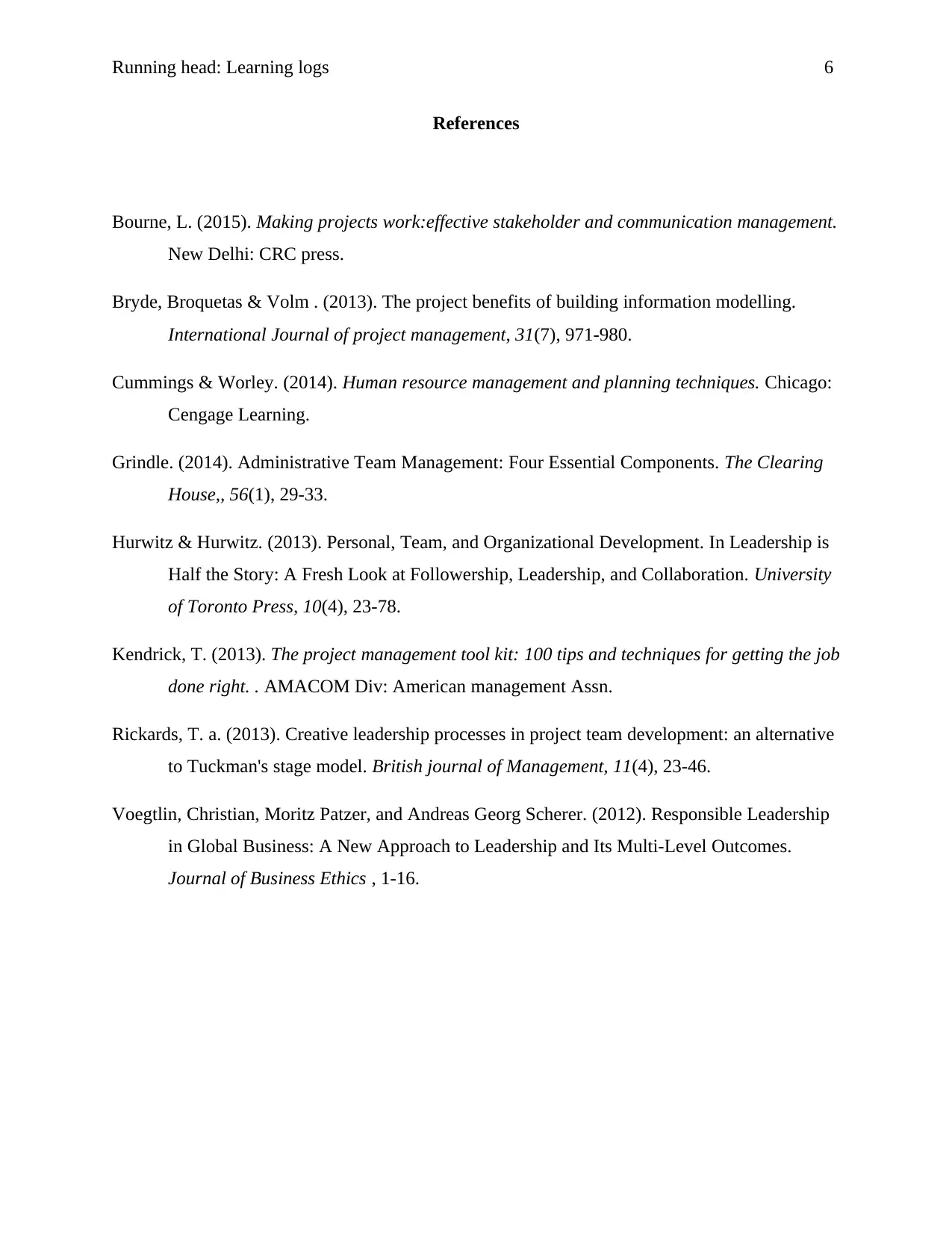
Running head: Learning logs 6
References
Bourne, L. (2015). Making projects work:effective stakeholder and communication management.
New Delhi: CRC press.
Bryde, Broquetas & Volm . (2013). The project benefits of building information modelling.
International Journal of project management, 31(7), 971-980.
Cummings & Worley. (2014). Human resource management and planning techniques. Chicago:
Cengage Learning.
Grindle. (2014). Administrative Team Management: Four Essential Components. The Clearing
House,, 56(1), 29-33.
Hurwitz & Hurwitz. (2013). Personal, Team, and Organizational Development. In Leadership is
Half the Story: A Fresh Look at Followership, Leadership, and Collaboration. University
of Toronto Press, 10(4), 23-78.
Kendrick, T. (2013). The project management tool kit: 100 tips and techniques for getting the job
done right. . AMACOM Div: American management Assn.
Rickards, T. a. (2013). Creative leadership processes in project team development: an alternative
to Tuckman's stage model. British journal of Management, 11(4), 23-46.
Voegtlin, Christian, Moritz Patzer, and Andreas Georg Scherer. (2012). Responsible Leadership
in Global Business: A New Approach to Leadership and Its Multi-Level Outcomes.
Journal of Business Ethics , 1-16.
References
Bourne, L. (2015). Making projects work:effective stakeholder and communication management.
New Delhi: CRC press.
Bryde, Broquetas & Volm . (2013). The project benefits of building information modelling.
International Journal of project management, 31(7), 971-980.
Cummings & Worley. (2014). Human resource management and planning techniques. Chicago:
Cengage Learning.
Grindle. (2014). Administrative Team Management: Four Essential Components. The Clearing
House,, 56(1), 29-33.
Hurwitz & Hurwitz. (2013). Personal, Team, and Organizational Development. In Leadership is
Half the Story: A Fresh Look at Followership, Leadership, and Collaboration. University
of Toronto Press, 10(4), 23-78.
Kendrick, T. (2013). The project management tool kit: 100 tips and techniques for getting the job
done right. . AMACOM Div: American management Assn.
Rickards, T. a. (2013). Creative leadership processes in project team development: an alternative
to Tuckman's stage model. British journal of Management, 11(4), 23-46.
Voegtlin, Christian, Moritz Patzer, and Andreas Georg Scherer. (2012). Responsible Leadership
in Global Business: A New Approach to Leadership and Its Multi-Level Outcomes.
Journal of Business Ethics , 1-16.
⊘ This is a preview!⊘
Do you want full access?
Subscribe today to unlock all pages.

Trusted by 1+ million students worldwide
1 out of 6
Related Documents
Your All-in-One AI-Powered Toolkit for Academic Success.
+13062052269
info@desklib.com
Available 24*7 on WhatsApp / Email
![[object Object]](/_next/static/media/star-bottom.7253800d.svg)
Unlock your academic potential
Copyright © 2020–2025 A2Z Services. All Rights Reserved. Developed and managed by ZUCOL.





